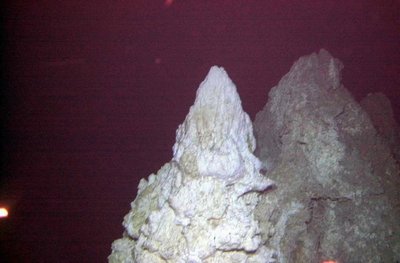December 12, 2000
Hydrothermal vent system unlike any seen before found in Atlantic
A new hydrothermal vent field, which scientists have dubbed “The Lost City,” was discovered Dec. 4 on an undersea mountain in the Atlantic Ocean. The unexpected discovery occurred at 30 degrees North on the Mid-Atlantic Ridge during an oceanographic cruise aboard the research vessel Atlantis.
A team of scientists led by Deborah Kelley from the University of Washington, Donna Blackman from the Scripps Institution of Oceanography and Jeff Karson of Duke University conducted the National Science Foundation-supported expedition.
“We thought that we had seen the entire spectrum of hydrothermal activity on the seafloor, but this major discovery reminds us that the ocean still has much to reveal, “says Margaret Leinen, NSF assistant director for geosciences.
“These structures, which tower 180 feet above the seafloor, are the largest hydrothermal chimneys of their kind ever observed,” said Deborah Kelley, a University of Washington geologist and co-principal investigator on the cruise.
Most previously studied vents are less than 80 feet high, the tallest being a 135-foot vent dubbed Godzilla, on the seafloor off the Washington state coast. It toppled in half a few years ago.
“If this vent field was on land, it would be a national park,” Duke University structural geologist Jeff Karson said of the new find. Karson, a second co-principal investigator, joined Kelley in the submersible Alvin on a dive to the site on Dec. 5.
Perhaps most surprising is that the venting structures are composed of carbonate minerals and silica, in contrast to most other mid-ocean ridge hot spring deposits, which are formed by iron and sulfur-based minerals. The low-temperature hydrothermal fluids may have unusual chemistries because they emanate from mantle rocks.
Nothing like this submarine hydrothermal field has ever been previously observed, say the scientists. These events are unique, they believe, because they rest on one-million-year-old ocean crust formed tens of kilometers beneath the seafloor, and because of their incredible size. Dense macrofaunal communities such as clams, shrimps, mussels, and tube worms, which typify most other mid-ocean ridge hydrothermal environments, appear to be absent in this field. The Lost City Field was discovered unexpectedly while studying geological and hydrothermal processes that built an unusually tall, 12,000-foot-mountain at this site. In this area, deep mantle rocks called serpentinized peridotites, and rocks crystallized in subseafloor magma chambers, have been uplifted several miles from beneath the seafloor along large faults that expose them at the surface of the mountain.
“As so often happens, we were pursuing one set of questions concerning building of the mountain and we stumbled onto a very important new discovery,” said Donna Blackman, a geophysicist from the Scripps Institution of Oceanography and chief scientist of the expedition. She added that “the venting towers are very spectacular and, although they bring up a whole new set of questions, we will learn about the evolution of the mountain itself as we study the vents carefully in the future.”
Observations using the submersible Alvin and deep-towed vehicle Argo, operated by Woods Hole Oceanographic Institution, show that the field hosts numerous active and inactive hydrothermal vents. The steep-sided, 180-foot-tall deposits are composed of multiple spires that reach 30 feet in width at their tops. They are commonly capped by white, feathery hydrothermal precipitates. The tops and sides of the massive edifices are awash in fluids that reach temperatures up to 160 degrees.
From the sides of the structures, abundant arrays of delicate, white flanges emerge. Similar to cave deposits, complex, intergrown stalagmites rise several meters above the flange roofs.
Underneath the flanges, trapped pools of warm fluid support dense mats of microbial communities that wave within the rising fluids. Downslope, hundreds of overlapping flanges form hydrothermal deposits reminiscent of hot spring deposits in Yellowstone National Park. During the Alvin dive, expedition leader Patrick Hickey collected rocks, fluids, and biological samples for shore-based analyses.
“By studying such environments, we may learn about ancient hydrothermal systems and the life that they support,” suggested Kelley.
###
Kelley, Blackman and Karson are at sea until Saturday, Dec. 16, and return to their home institutions from there.
The three principal scientists may be contacted aboard ship until Sat. Dec.16. (Note: e-mail is only sent and received three times a day.)
Donna Blackman
Debbie Kelley
Jeff Karson
Expedition web site:
http://earthguide.ucsd.edu/mar



